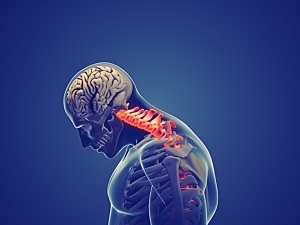After adult cervical deformity (ACD) surgery, complication rates remain high despite recent improvements in surgical approaches, intraoperative management, and anesthesia techniques. Yet mortality has not received much attention.
Peter G. Passias, MD, of NYU Langone Orthopedic Hospital, Andrew J. Schoenfeld, MD, MSc, of the Department of Orthopaedic Surgery at Brigham and Women’s Hospital, and colleagues have completed the first long-term (10-year) survival analysis after ACD surgery. In The Spine Journal, they say preoperative body mass index (BMI), preoperative frailty status, and fusion length affected mortality rates.
Methods
The retrospective study included 66 adults (70% female) with cervical deformity enrolled in a prospectively collected database at the NYU Spine Institute between 2012 and 2021. At the time of surgery, the mean age was 62, the mean BMI was 28 kg/m2, and the mean Charlson Comorbidity Index (CCI) score was 0.76. Osteotomy was part of the procedure for 61% of patients.
At baseline and multiple follow-up time points, metrics on health-related quality of life (HRQL) were collected from patient surveys:
- Neck Disability Index (NDI)
- Numeric rating scale for the neck
- Numeric rating scale for the back
- Euro-QOL 5-Dimension Questionnaire (EQ5D)
- Modified Japanese Orthopaedic Association (mJOA) scale
Patients were also assessed with the modified Cervical Deformity Frailty Index (mCD-FI), where a score of <0.3 indicates no frailty, 0.3–0.5 indicates frailty, and >0.5 indicates severe frailty. The mean score at baseline was 0.41.
Mortality Rates and Associations
Twelve patients (18%) died within 10 years after initial surgery, including seven (58%) who died within two years.
The group of patients who died and those who survived were comparable in gender, baseline average age, baseline average BMI, baseline CCI score, and all baseline HRQLs. However:
- Patients who died between five and 10 years after surgery had higher baseline EQ5D and mJOA scale scores than those who died within two years (P<0.021)
- Patients who had no baseline CCI markers were significantly more likely than those who had one or more markers to survive for at least five years (P<0.5)
- Patients who underwent osteotomy were less likely to survive for at least five years than those who did not require it (P=0.003)
Predictors of Mortality
Logistic regression revealed:
- Independent predictors of death within five years were increased BMI, increased frailty, and a greater number of levels fused
- A greater number of levels fused was itself associated significantly with increased frailty
- Patients who were not frail at baseline according to the mCD-FI survived for an average of 171 weeks vs. 158 weeks for frail patients, although the difference was not statistically significant
Implications for Treatment Planning
These findings should guide patient counseling and shared decision-making about whether to proceed with ACD surgery. Preoperative optimization of BMI and frailty status may increase the chance of long-term survival.
Higher osteotomy grades lead to longer operation times, increased blood loss and a longer hospital stay. Minimization of surgical invasiveness, when possible, may reduce the risk of mortality.
